Project Management Report: IT and Communication Infrastructure
VerifiedAdded on 2023/01/06
|18
|4198
|89
Report
AI Summary
This report delves into the core principles of project management, encompassing two primary tasks. Task 1 explores the fundamental characteristics of projects, reasons for failure, and the benefits of well-structured project management. It examines the importance of teamwork, knowledge areas, and the attributes of a successful project manager. Furthermore, it highlights the advantages of using network diagrams and includes a critical path analysis. Task 2 focuses on a specific project: the installation, testing, and commissioning of IT and communication infrastructure for a new conference center. This includes defining project objectives, outlining the project's scope and timescale, and conducting a stakeholder analysis. The report also details a comprehensive budget, a risk register, and a detailed project plan, including a Gantt chart and a work breakdown structure. The project covers all stages of project management from initiation to closure.
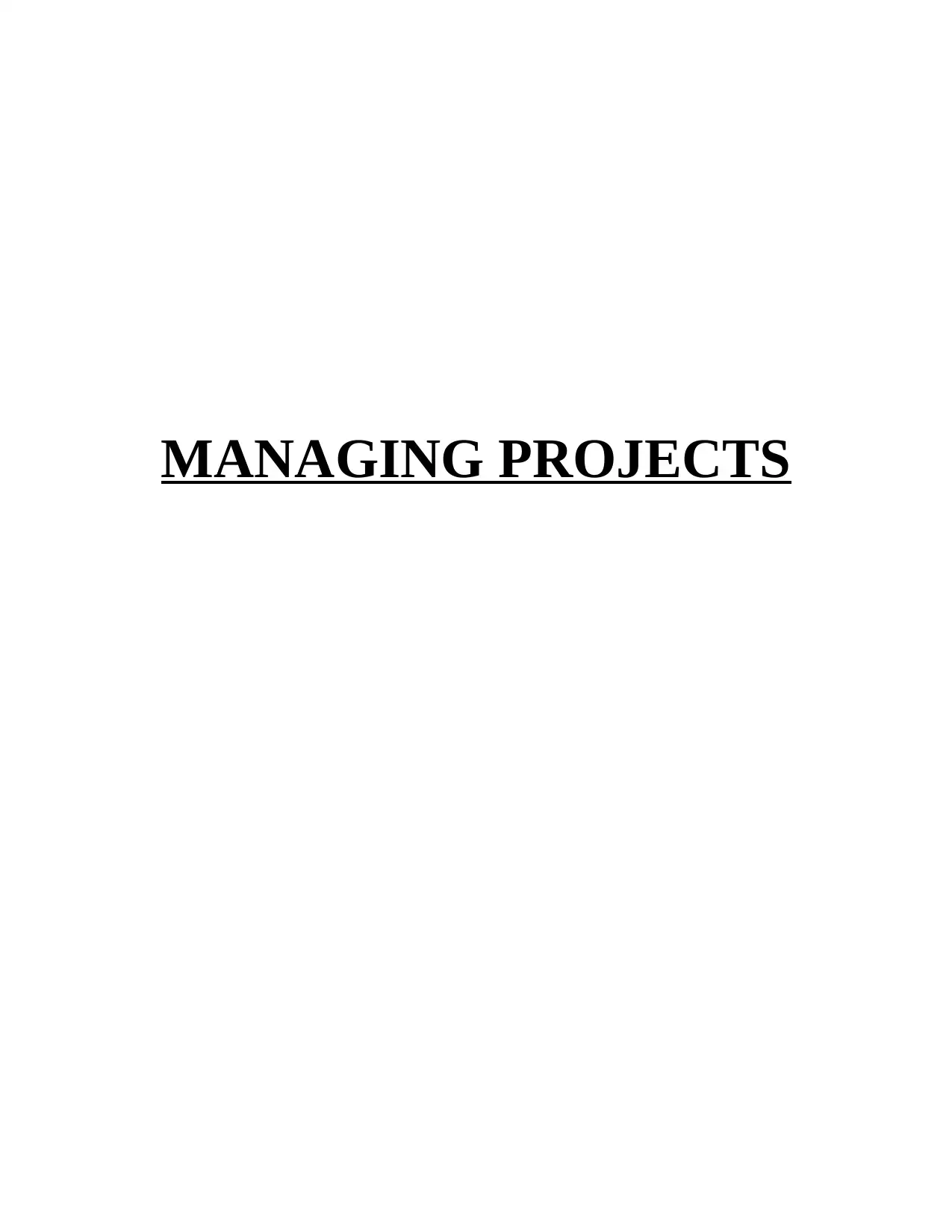
MANAGING PROJECTS
Paraphrase This Document
Need a fresh take? Get an instant paraphrase of this document with our AI Paraphraser
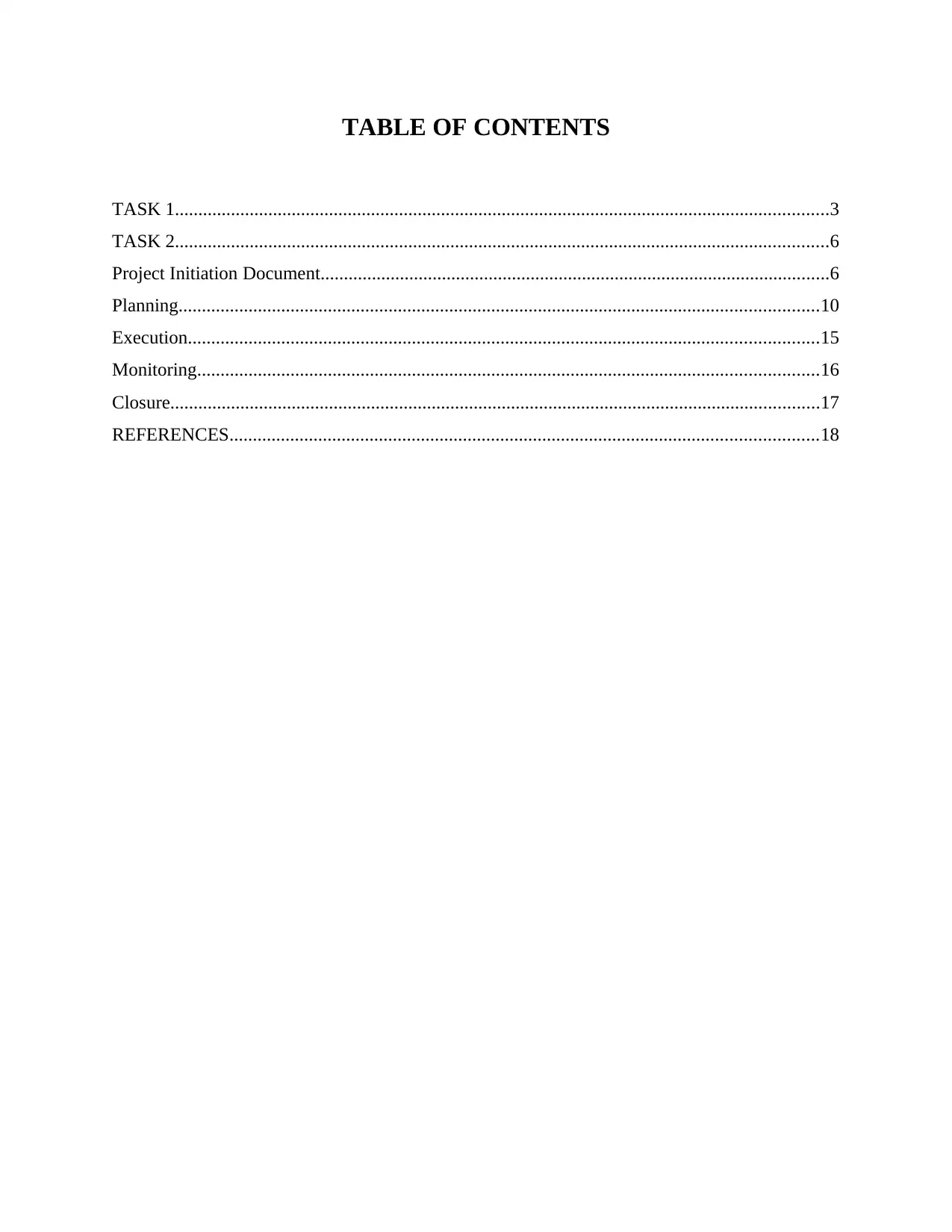
TABLE OF CONTENTS
TASK 1............................................................................................................................................3
TASK 2............................................................................................................................................6
Project Initiation Document.............................................................................................................6
Planning.........................................................................................................................................10
Execution.......................................................................................................................................15
Monitoring.....................................................................................................................................16
Closure...........................................................................................................................................17
REFERENCES..............................................................................................................................18
TASK 1............................................................................................................................................3
TASK 2............................................................................................................................................6
Project Initiation Document.............................................................................................................6
Planning.........................................................................................................................................10
Execution.......................................................................................................................................15
Monitoring.....................................................................................................................................16
Closure...........................................................................................................................................17
REFERENCES..............................................................................................................................18
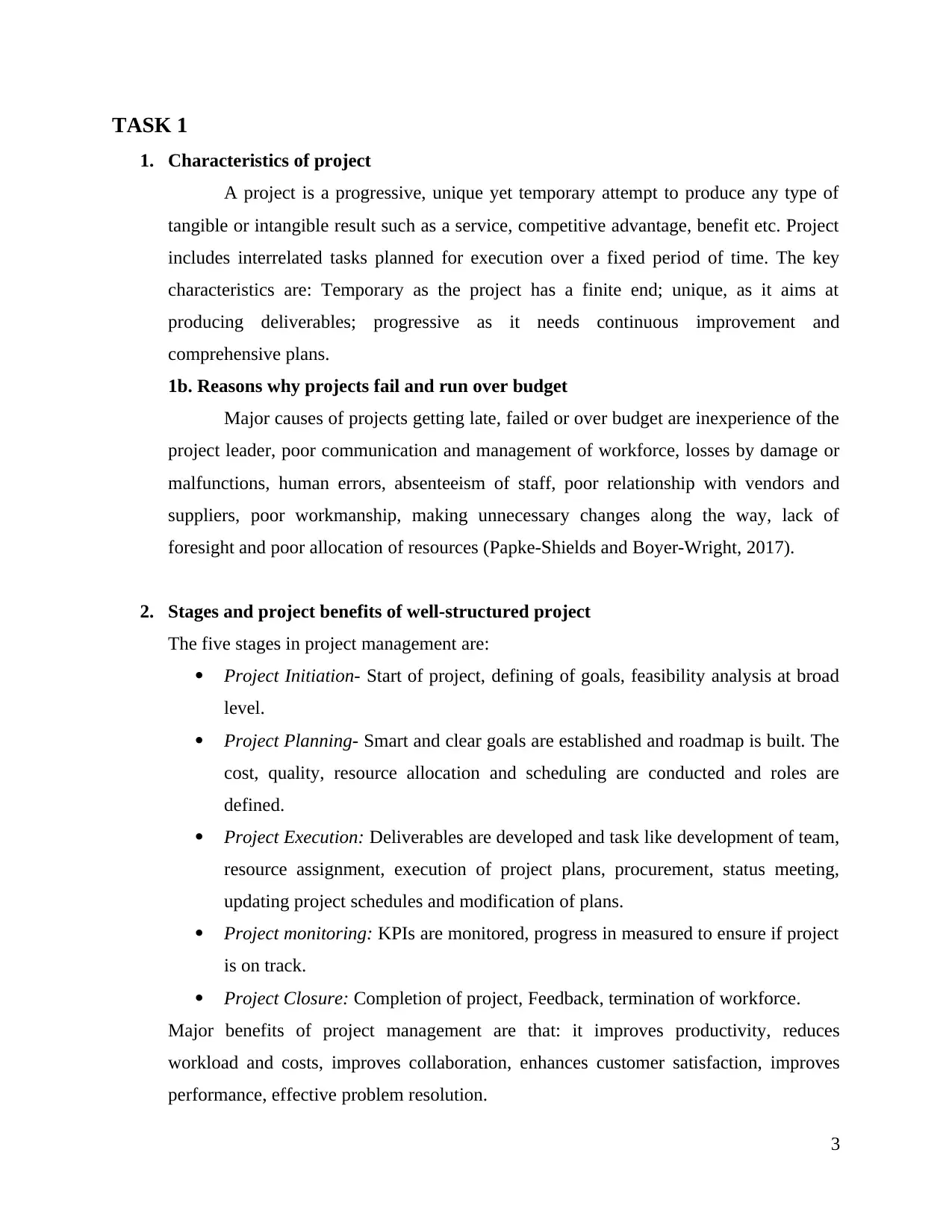
TASK 1
1. Characteristics of project
A project is a progressive, unique yet temporary attempt to produce any type of
tangible or intangible result such as a service, competitive advantage, benefit etc. Project
includes interrelated tasks planned for execution over a fixed period of time. The key
characteristics are: Temporary as the project has a finite end; unique, as it aims at
producing deliverables; progressive as it needs continuous improvement and
comprehensive plans.
1b. Reasons why projects fail and run over budget
Major causes of projects getting late, failed or over budget are inexperience of the
project leader, poor communication and management of workforce, losses by damage or
malfunctions, human errors, absenteeism of staff, poor relationship with vendors and
suppliers, poor workmanship, making unnecessary changes along the way, lack of
foresight and poor allocation of resources (Papke-Shields and Boyer-Wright, 2017).
2. Stages and project benefits of well-structured project
The five stages in project management are:
Project Initiation- Start of project, defining of goals, feasibility analysis at broad
level.
Project Planning- Smart and clear goals are established and roadmap is built. The
cost, quality, resource allocation and scheduling are conducted and roles are
defined.
Project Execution: Deliverables are developed and task like development of team,
resource assignment, execution of project plans, procurement, status meeting,
updating project schedules and modification of plans.
Project monitoring: KPIs are monitored, progress in measured to ensure if project
is on track.
Project Closure: Completion of project, Feedback, termination of workforce.
Major benefits of project management are that: it improves productivity, reduces
workload and costs, improves collaboration, enhances customer satisfaction, improves
performance, effective problem resolution.
3
1. Characteristics of project
A project is a progressive, unique yet temporary attempt to produce any type of
tangible or intangible result such as a service, competitive advantage, benefit etc. Project
includes interrelated tasks planned for execution over a fixed period of time. The key
characteristics are: Temporary as the project has a finite end; unique, as it aims at
producing deliverables; progressive as it needs continuous improvement and
comprehensive plans.
1b. Reasons why projects fail and run over budget
Major causes of projects getting late, failed or over budget are inexperience of the
project leader, poor communication and management of workforce, losses by damage or
malfunctions, human errors, absenteeism of staff, poor relationship with vendors and
suppliers, poor workmanship, making unnecessary changes along the way, lack of
foresight and poor allocation of resources (Papke-Shields and Boyer-Wright, 2017).
2. Stages and project benefits of well-structured project
The five stages in project management are:
Project Initiation- Start of project, defining of goals, feasibility analysis at broad
level.
Project Planning- Smart and clear goals are established and roadmap is built. The
cost, quality, resource allocation and scheduling are conducted and roles are
defined.
Project Execution: Deliverables are developed and task like development of team,
resource assignment, execution of project plans, procurement, status meeting,
updating project schedules and modification of plans.
Project monitoring: KPIs are monitored, progress in measured to ensure if project
is on track.
Project Closure: Completion of project, Feedback, termination of workforce.
Major benefits of project management are that: it improves productivity, reduces
workload and costs, improves collaboration, enhances customer satisfaction, improves
performance, effective problem resolution.
3
⊘ This is a preview!⊘
Do you want full access?
Subscribe today to unlock all pages.

Trusted by 1+ million students worldwide
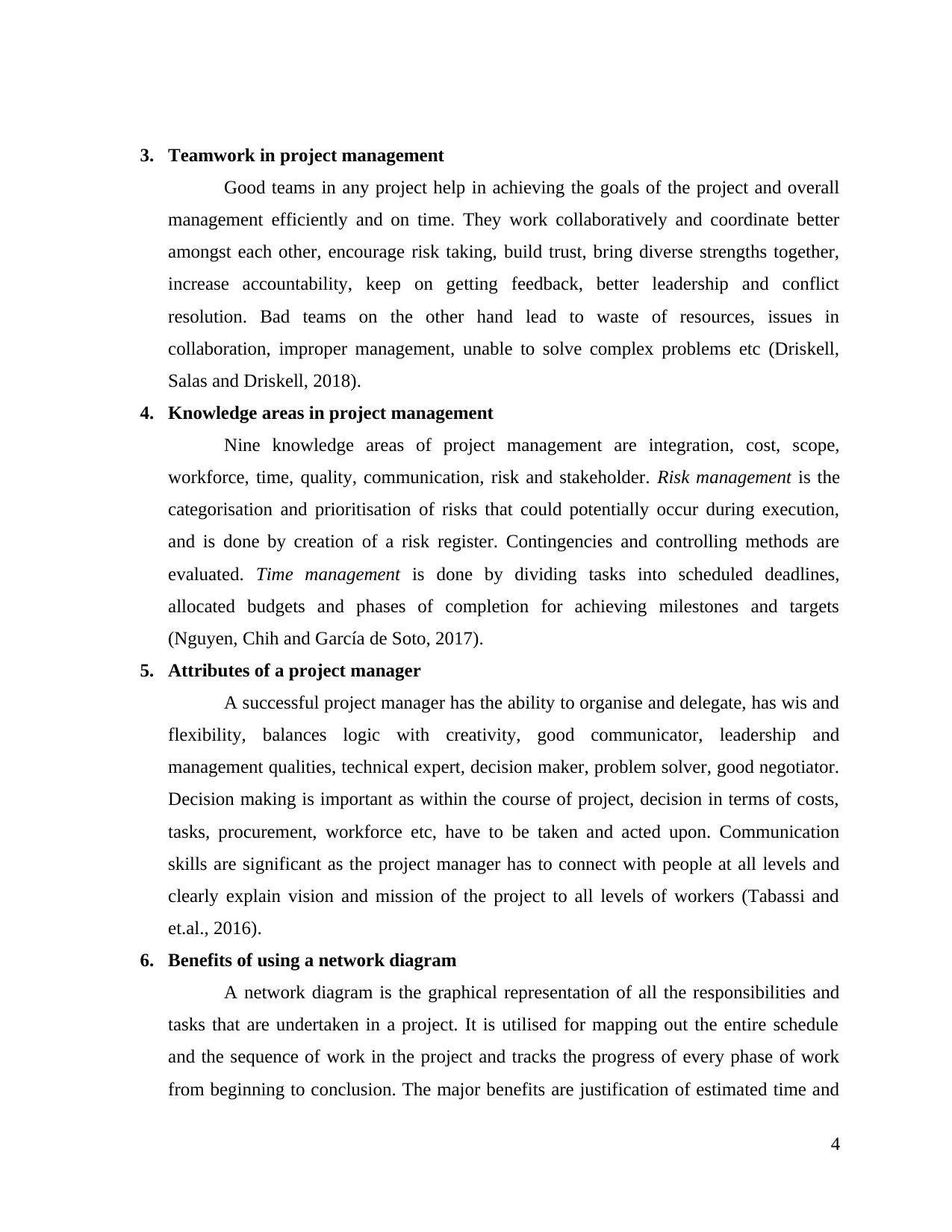
3. Teamwork in project management
Good teams in any project help in achieving the goals of the project and overall
management efficiently and on time. They work collaboratively and coordinate better
amongst each other, encourage risk taking, build trust, bring diverse strengths together,
increase accountability, keep on getting feedback, better leadership and conflict
resolution. Bad teams on the other hand lead to waste of resources, issues in
collaboration, improper management, unable to solve complex problems etc (Driskell,
Salas and Driskell, 2018).
4. Knowledge areas in project management
Nine knowledge areas of project management are integration, cost, scope,
workforce, time, quality, communication, risk and stakeholder. Risk management is the
categorisation and prioritisation of risks that could potentially occur during execution,
and is done by creation of a risk register. Contingencies and controlling methods are
evaluated. Time management is done by dividing tasks into scheduled deadlines,
allocated budgets and phases of completion for achieving milestones and targets
(Nguyen, Chih and García de Soto, 2017).
5. Attributes of a project manager
A successful project manager has the ability to organise and delegate, has wis and
flexibility, balances logic with creativity, good communicator, leadership and
management qualities, technical expert, decision maker, problem solver, good negotiator.
Decision making is important as within the course of project, decision in terms of costs,
tasks, procurement, workforce etc, have to be taken and acted upon. Communication
skills are significant as the project manager has to connect with people at all levels and
clearly explain vision and mission of the project to all levels of workers (Tabassi and
et.al., 2016).
6. Benefits of using a network diagram
A network diagram is the graphical representation of all the responsibilities and
tasks that are undertaken in a project. It is utilised for mapping out the entire schedule
and the sequence of work in the project and tracks the progress of every phase of work
from beginning to conclusion. The major benefits are justification of estimated time and
4
Good teams in any project help in achieving the goals of the project and overall
management efficiently and on time. They work collaboratively and coordinate better
amongst each other, encourage risk taking, build trust, bring diverse strengths together,
increase accountability, keep on getting feedback, better leadership and conflict
resolution. Bad teams on the other hand lead to waste of resources, issues in
collaboration, improper management, unable to solve complex problems etc (Driskell,
Salas and Driskell, 2018).
4. Knowledge areas in project management
Nine knowledge areas of project management are integration, cost, scope,
workforce, time, quality, communication, risk and stakeholder. Risk management is the
categorisation and prioritisation of risks that could potentially occur during execution,
and is done by creation of a risk register. Contingencies and controlling methods are
evaluated. Time management is done by dividing tasks into scheduled deadlines,
allocated budgets and phases of completion for achieving milestones and targets
(Nguyen, Chih and García de Soto, 2017).
5. Attributes of a project manager
A successful project manager has the ability to organise and delegate, has wis and
flexibility, balances logic with creativity, good communicator, leadership and
management qualities, technical expert, decision maker, problem solver, good negotiator.
Decision making is important as within the course of project, decision in terms of costs,
tasks, procurement, workforce etc, have to be taken and acted upon. Communication
skills are significant as the project manager has to connect with people at all levels and
clearly explain vision and mission of the project to all levels of workers (Tabassi and
et.al., 2016).
6. Benefits of using a network diagram
A network diagram is the graphical representation of all the responsibilities and
tasks that are undertaken in a project. It is utilised for mapping out the entire schedule
and the sequence of work in the project and tracks the progress of every phase of work
from beginning to conclusion. The major benefits are justification of estimated time and
4
Paraphrase This Document
Need a fresh take? Get an instant paraphrase of this document with our AI Paraphraser
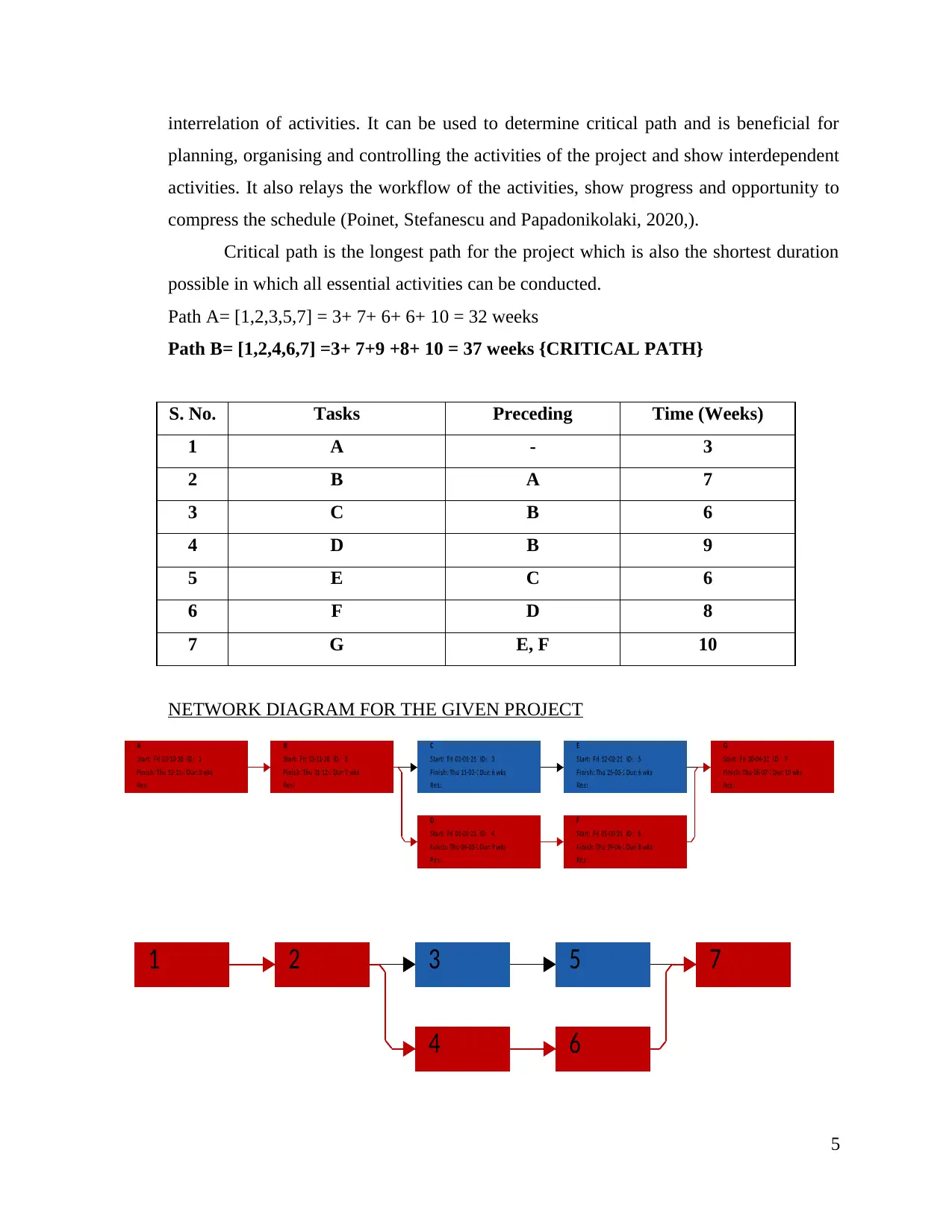
interrelation of activities. It can be used to determine critical path and is beneficial for
planning, organising and controlling the activities of the project and show interdependent
activities. It also relays the workflow of the activities, show progress and opportunity to
compress the schedule (Poinet, Stefanescu and Papadonikolaki, 2020,).
Critical path is the longest path for the project which is also the shortest duration
possible in which all essential activities can be conducted.
Path A= [1,2,3,5,7] = 3+ 7+ 6+ 6+ 10 = 32 weeks
Path B= [1,2,4,6,7] =3+ 7+9 +8+ 10 = 37 weeks {CRITICAL PATH}
S. No. Tasks Preceding Time (Weeks)
1 A - 3
2 B A 7
3 C B 6
4 D B 9
5 E C 6
6 F D 8
7 G E, F 10
NETWORK DIAGRAM FOR THE GIVEN PROJECT
B
Sta rt: Fri 13-11-20 ID: 2
Finis h: Thu 31-12-20Dur: 7 wks
Res:
C
Start: Fri 01-01-21 ID: 3
Fi ni s h: Thu 11-02-21Dur: 6 wks
Res:
D
Start: Fri 01-01-21 ID: 4
Fi ni s h: Thu 04-03-21Dur: 9 wks
Res:
E
Sta rt: Fri 12-02-21 ID: 5
Finis h: Thu 25-03-21Dur: 6 wks
Res:
F
Sta rt: Fri 05-03-21 ID: 6
Finis h: Thu 29-04-21Dur: 8 wks
Res:
G
Sta rt: Fri 30-04-21 ID: 7
Finis h: Thu 08-07-21Dur: 10 wks
Res:
A
Sta rt: Fri 23-10-20 ID: 1
Finis h: Thu 12-11-20Dur: 3 wks
Res:
2 3
4
5
6
71
5
planning, organising and controlling the activities of the project and show interdependent
activities. It also relays the workflow of the activities, show progress and opportunity to
compress the schedule (Poinet, Stefanescu and Papadonikolaki, 2020,).
Critical path is the longest path for the project which is also the shortest duration
possible in which all essential activities can be conducted.
Path A= [1,2,3,5,7] = 3+ 7+ 6+ 6+ 10 = 32 weeks
Path B= [1,2,4,6,7] =3+ 7+9 +8+ 10 = 37 weeks {CRITICAL PATH}
S. No. Tasks Preceding Time (Weeks)
1 A - 3
2 B A 7
3 C B 6
4 D B 9
5 E C 6
6 F D 8
7 G E, F 10
NETWORK DIAGRAM FOR THE GIVEN PROJECT
B
Sta rt: Fri 13-11-20 ID: 2
Finis h: Thu 31-12-20Dur: 7 wks
Res:
C
Start: Fri 01-01-21 ID: 3
Fi ni s h: Thu 11-02-21Dur: 6 wks
Res:
D
Start: Fri 01-01-21 ID: 4
Fi ni s h: Thu 04-03-21Dur: 9 wks
Res:
E
Sta rt: Fri 12-02-21 ID: 5
Finis h: Thu 25-03-21Dur: 6 wks
Res:
F
Sta rt: Fri 05-03-21 ID: 6
Finis h: Thu 29-04-21Dur: 8 wks
Res:
G
Sta rt: Fri 30-04-21 ID: 7
Finis h: Thu 08-07-21Dur: 10 wks
Res:
A
Sta rt: Fri 23-10-20 ID: 1
Finis h: Thu 12-11-20Dur: 3 wks
Res:
2 3
4
5
6
71
5
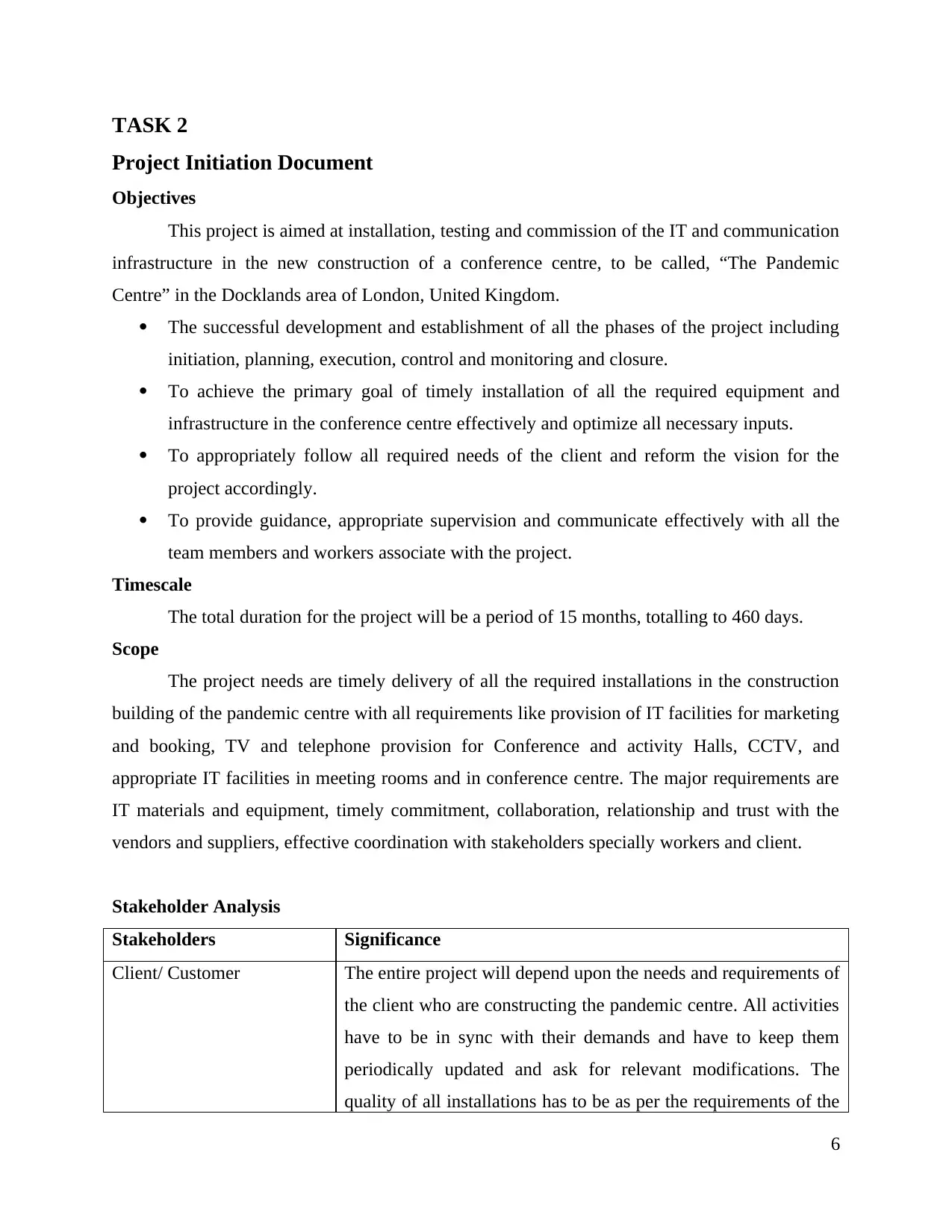
TASK 2
Project Initiation Document
Objectives
This project is aimed at installation, testing and commission of the IT and communication
infrastructure in the new construction of a conference centre, to be called, “The Pandemic
Centre” in the Docklands area of London, United Kingdom.
The successful development and establishment of all the phases of the project including
initiation, planning, execution, control and monitoring and closure.
To achieve the primary goal of timely installation of all the required equipment and
infrastructure in the conference centre effectively and optimize all necessary inputs.
To appropriately follow all required needs of the client and reform the vision for the
project accordingly.
To provide guidance, appropriate supervision and communicate effectively with all the
team members and workers associate with the project.
Timescale
The total duration for the project will be a period of 15 months, totalling to 460 days.
Scope
The project needs are timely delivery of all the required installations in the construction
building of the pandemic centre with all requirements like provision of IT facilities for marketing
and booking, TV and telephone provision for Conference and activity Halls, CCTV, and
appropriate IT facilities in meeting rooms and in conference centre. The major requirements are
IT materials and equipment, timely commitment, collaboration, relationship and trust with the
vendors and suppliers, effective coordination with stakeholders specially workers and client.
Stakeholder Analysis
Stakeholders Significance
Client/ Customer The entire project will depend upon the needs and requirements of
the client who are constructing the pandemic centre. All activities
have to be in sync with their demands and have to keep them
periodically updated and ask for relevant modifications. The
quality of all installations has to be as per the requirements of the
6
Project Initiation Document
Objectives
This project is aimed at installation, testing and commission of the IT and communication
infrastructure in the new construction of a conference centre, to be called, “The Pandemic
Centre” in the Docklands area of London, United Kingdom.
The successful development and establishment of all the phases of the project including
initiation, planning, execution, control and monitoring and closure.
To achieve the primary goal of timely installation of all the required equipment and
infrastructure in the conference centre effectively and optimize all necessary inputs.
To appropriately follow all required needs of the client and reform the vision for the
project accordingly.
To provide guidance, appropriate supervision and communicate effectively with all the
team members and workers associate with the project.
Timescale
The total duration for the project will be a period of 15 months, totalling to 460 days.
Scope
The project needs are timely delivery of all the required installations in the construction
building of the pandemic centre with all requirements like provision of IT facilities for marketing
and booking, TV and telephone provision for Conference and activity Halls, CCTV, and
appropriate IT facilities in meeting rooms and in conference centre. The major requirements are
IT materials and equipment, timely commitment, collaboration, relationship and trust with the
vendors and suppliers, effective coordination with stakeholders specially workers and client.
Stakeholder Analysis
Stakeholders Significance
Client/ Customer The entire project will depend upon the needs and requirements of
the client who are constructing the pandemic centre. All activities
have to be in sync with their demands and have to keep them
periodically updated and ask for relevant modifications. The
quality of all installations has to be as per the requirements of the
6
⊘ This is a preview!⊘
Do you want full access?
Subscribe today to unlock all pages.

Trusted by 1+ million students worldwide
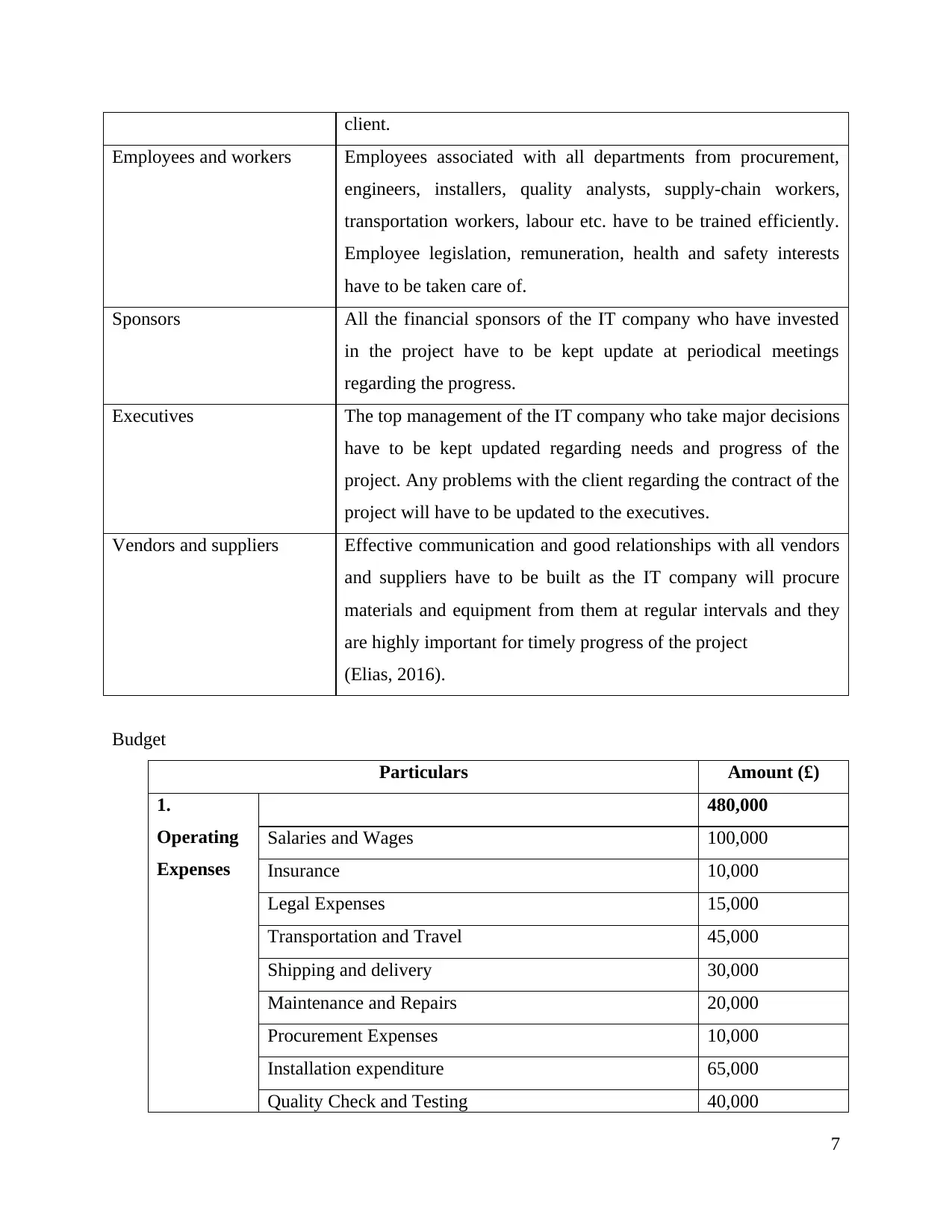
client.
Employees and workers Employees associated with all departments from procurement,
engineers, installers, quality analysts, supply-chain workers,
transportation workers, labour etc. have to be trained efficiently.
Employee legislation, remuneration, health and safety interests
have to be taken care of.
Sponsors All the financial sponsors of the IT company who have invested
in the project have to be kept update at periodical meetings
regarding the progress.
Executives The top management of the IT company who take major decisions
have to be kept updated regarding needs and progress of the
project. Any problems with the client regarding the contract of the
project will have to be updated to the executives.
Vendors and suppliers Effective communication and good relationships with all vendors
and suppliers have to be built as the IT company will procure
materials and equipment from them at regular intervals and they
are highly important for timely progress of the project
(Elias, 2016).
Budget
Particulars Amount (£)
1.
Operating
Expenses
480,000
Salaries and Wages 100,000
Insurance 10,000
Legal Expenses 15,000
Transportation and Travel 45,000
Shipping and delivery 30,000
Maintenance and Repairs 20,000
Procurement Expenses 10,000
Installation expenditure 65,000
Quality Check and Testing 40,000
7
Employees and workers Employees associated with all departments from procurement,
engineers, installers, quality analysts, supply-chain workers,
transportation workers, labour etc. have to be trained efficiently.
Employee legislation, remuneration, health and safety interests
have to be taken care of.
Sponsors All the financial sponsors of the IT company who have invested
in the project have to be kept update at periodical meetings
regarding the progress.
Executives The top management of the IT company who take major decisions
have to be kept updated regarding needs and progress of the
project. Any problems with the client regarding the contract of the
project will have to be updated to the executives.
Vendors and suppliers Effective communication and good relationships with all vendors
and suppliers have to be built as the IT company will procure
materials and equipment from them at regular intervals and they
are highly important for timely progress of the project
(Elias, 2016).
Budget
Particulars Amount (£)
1.
Operating
Expenses
480,000
Salaries and Wages 100,000
Insurance 10,000
Legal Expenses 15,000
Transportation and Travel 45,000
Shipping and delivery 30,000
Maintenance and Repairs 20,000
Procurement Expenses 10,000
Installation expenditure 65,000
Quality Check and Testing 40,000
7
Paraphrase This Document
Need a fresh take? Get an instant paraphrase of this document with our AI Paraphraser
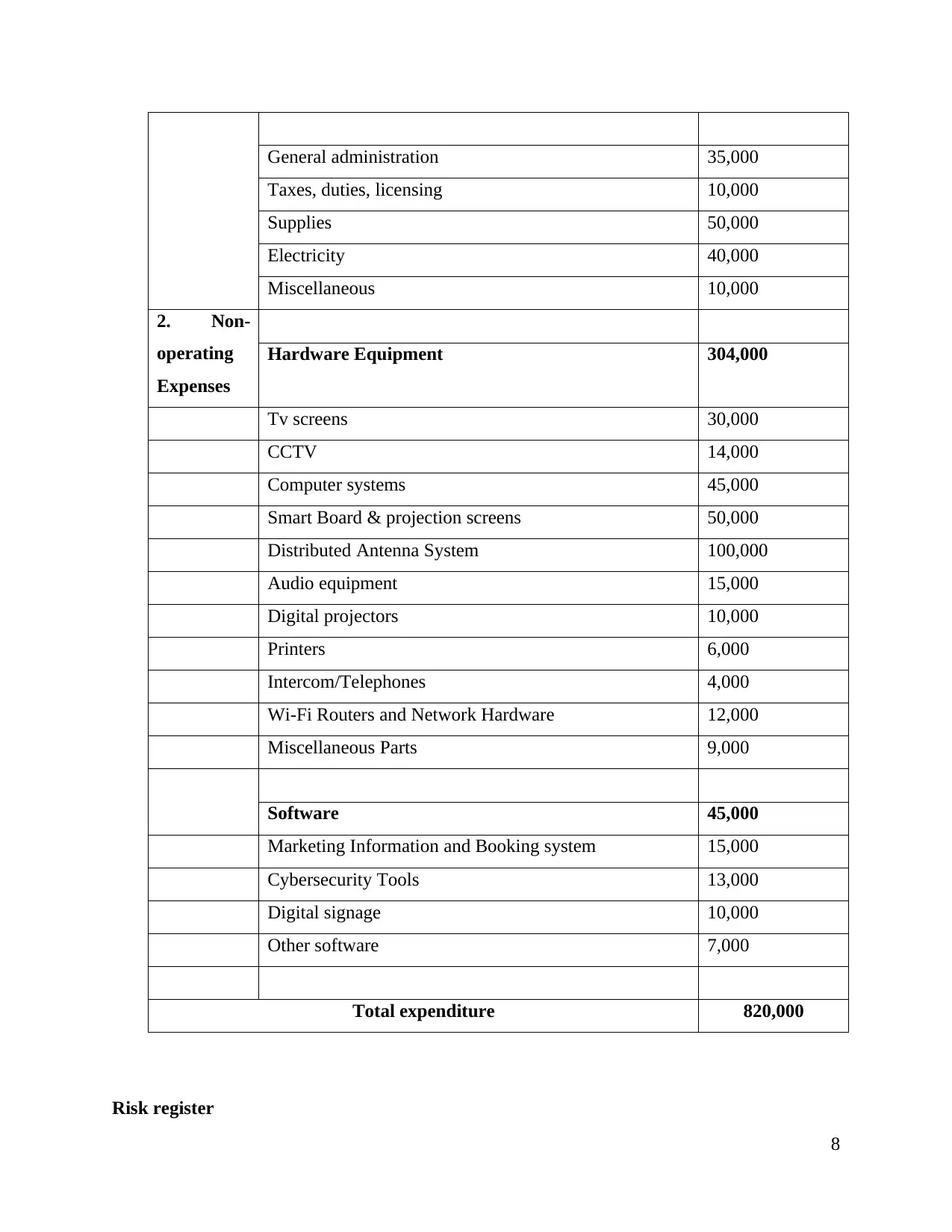
General administration 35,000
Taxes, duties, licensing 10,000
Supplies 50,000
Electricity 40,000
Miscellaneous 10,000
2. Non-
operating
Expenses
Hardware Equipment 304,000
Tv screens 30,000
CCTV 14,000
Computer systems 45,000
Smart Board & projection screens 50,000
Distributed Antenna System 100,000
Audio equipment 15,000
Digital projectors 10,000
Printers 6,000
Intercom/Telephones 4,000
Wi-Fi Routers and Network Hardware 12,000
Miscellaneous Parts 9,000
Software 45,000
Marketing Information and Booking system 15,000
Cybersecurity Tools 13,000
Digital signage 10,000
Other software 7,000
Total expenditure 820,000
Risk register
8
Taxes, duties, licensing 10,000
Supplies 50,000
Electricity 40,000
Miscellaneous 10,000
2. Non-
operating
Expenses
Hardware Equipment 304,000
Tv screens 30,000
CCTV 14,000
Computer systems 45,000
Smart Board & projection screens 50,000
Distributed Antenna System 100,000
Audio equipment 15,000
Digital projectors 10,000
Printers 6,000
Intercom/Telephones 4,000
Wi-Fi Routers and Network Hardware 12,000
Miscellaneous Parts 9,000
Software 45,000
Marketing Information and Booking system 15,000
Cybersecurity Tools 13,000
Digital signage 10,000
Other software 7,000
Total expenditure 820,000
Risk register
8
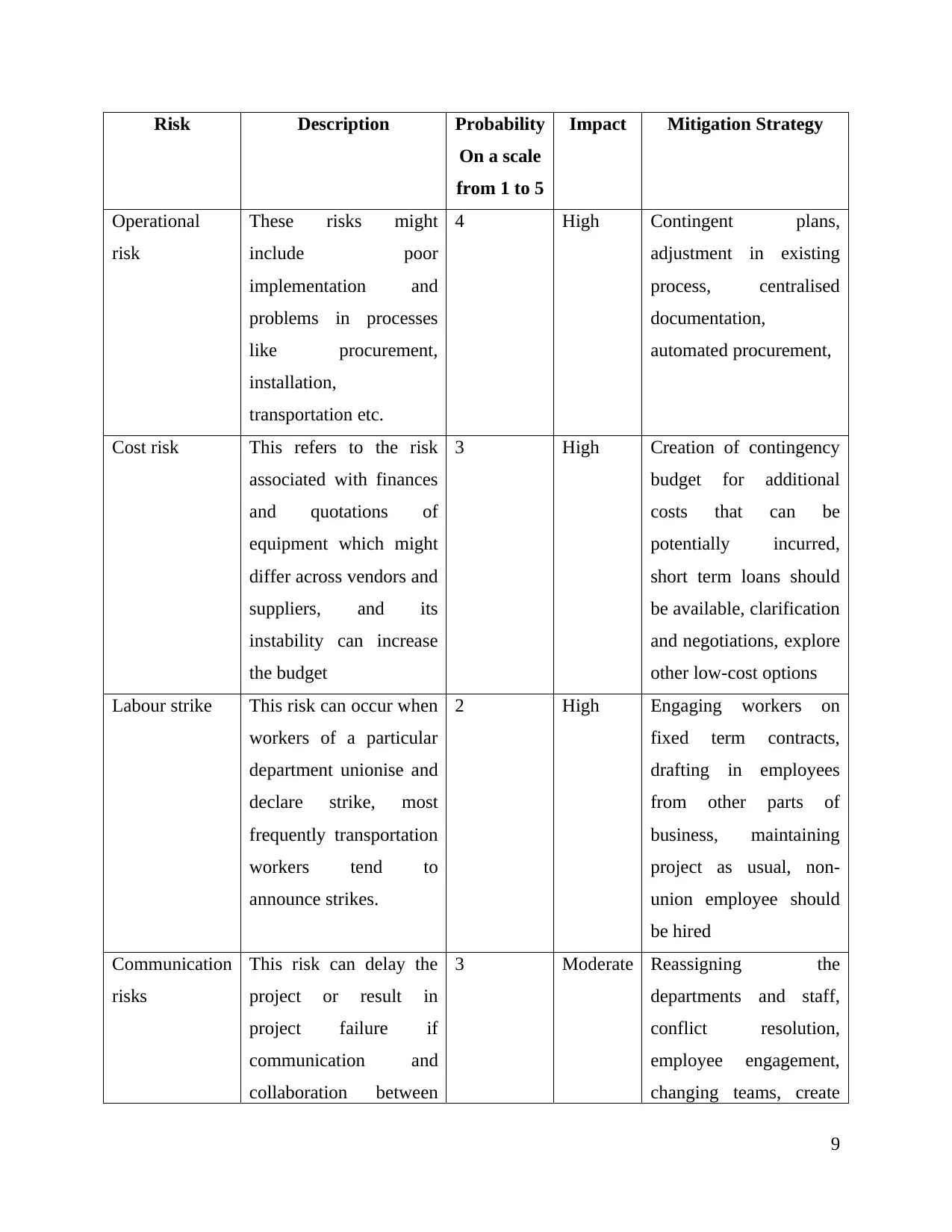
Risk Description Probability
On a scale
from 1 to 5
Impact Mitigation Strategy
Operational
risk
These risks might
include poor
implementation and
problems in processes
like procurement,
installation,
transportation etc.
4 High Contingent plans,
adjustment in existing
process, centralised
documentation,
automated procurement,
Cost risk This refers to the risk
associated with finances
and quotations of
equipment which might
differ across vendors and
suppliers, and its
instability can increase
the budget
3 High Creation of contingency
budget for additional
costs that can be
potentially incurred,
short term loans should
be available, clarification
and negotiations, explore
other low-cost options
Labour strike This risk can occur when
workers of a particular
department unionise and
declare strike, most
frequently transportation
workers tend to
announce strikes.
2 High Engaging workers on
fixed term contracts,
drafting in employees
from other parts of
business, maintaining
project as usual, non-
union employee should
be hired
Communication
risks
This risk can delay the
project or result in
project failure if
communication and
collaboration between
3 Moderate Reassigning the
departments and staff,
conflict resolution,
employee engagement,
changing teams, create
9
On a scale
from 1 to 5
Impact Mitigation Strategy
Operational
risk
These risks might
include poor
implementation and
problems in processes
like procurement,
installation,
transportation etc.
4 High Contingent plans,
adjustment in existing
process, centralised
documentation,
automated procurement,
Cost risk This refers to the risk
associated with finances
and quotations of
equipment which might
differ across vendors and
suppliers, and its
instability can increase
the budget
3 High Creation of contingency
budget for additional
costs that can be
potentially incurred,
short term loans should
be available, clarification
and negotiations, explore
other low-cost options
Labour strike This risk can occur when
workers of a particular
department unionise and
declare strike, most
frequently transportation
workers tend to
announce strikes.
2 High Engaging workers on
fixed term contracts,
drafting in employees
from other parts of
business, maintaining
project as usual, non-
union employee should
be hired
Communication
risks
This risk can delay the
project or result in
project failure if
communication and
collaboration between
3 Moderate Reassigning the
departments and staff,
conflict resolution,
employee engagement,
changing teams, create
9
⊘ This is a preview!⊘
Do you want full access?
Subscribe today to unlock all pages.

Trusted by 1+ million students worldwide
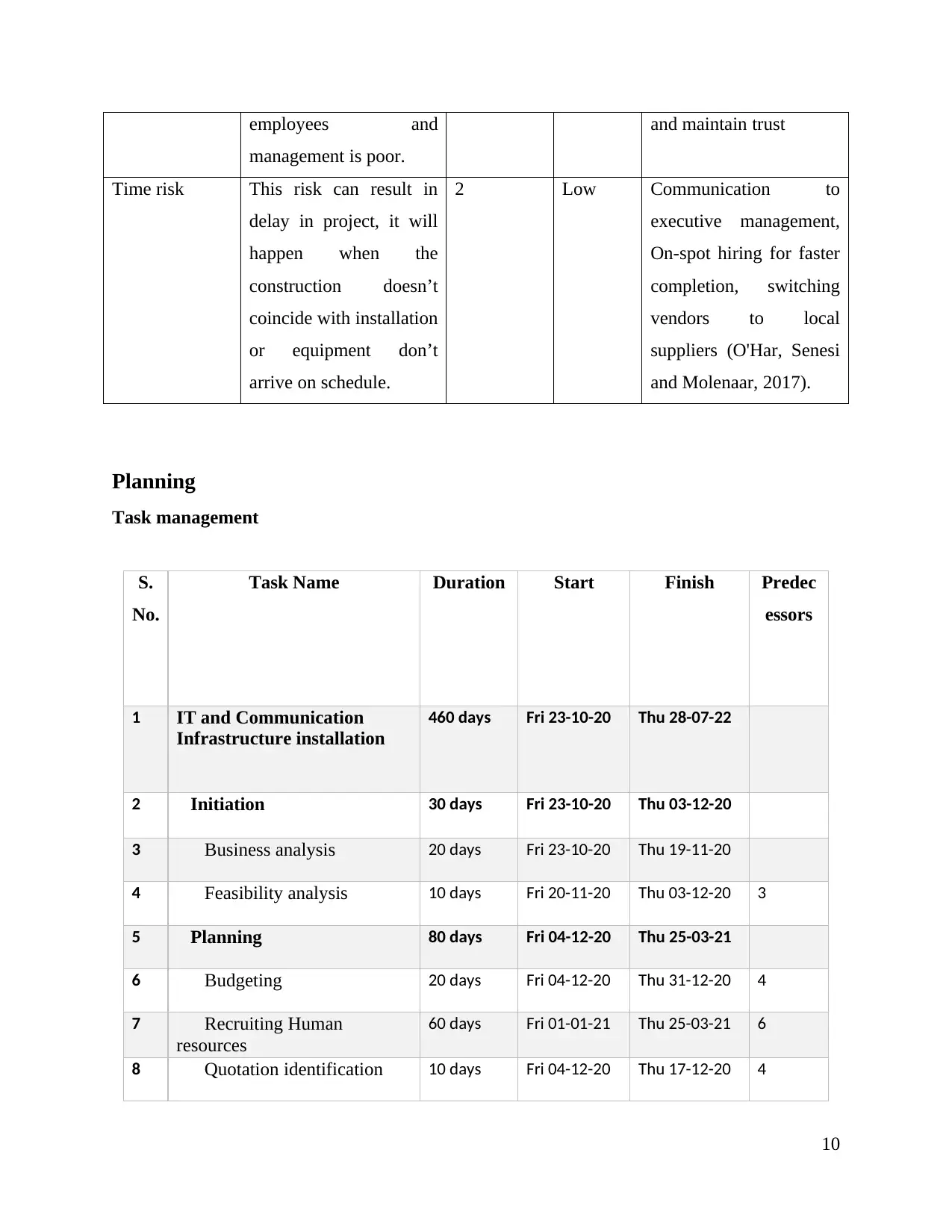
employees and
management is poor.
and maintain trust
Time risk This risk can result in
delay in project, it will
happen when the
construction doesn’t
coincide with installation
or equipment don’t
arrive on schedule.
2 Low Communication to
executive management,
On-spot hiring for faster
completion, switching
vendors to local
suppliers (O'Har, Senesi
and Molenaar, 2017).
Planning
Task management
S.
No.
Task Name Duration Start Finish Predec
essors
1 IT and Communication
Infrastructure installation
460 days Fri 23-10-20 Thu 28-07-22
2 Initiation 30 days Fri 23-10-20 Thu 03-12-20
3 Business analysis 20 days Fri 23-10-20 Thu 19-11-20
4 Feasibility analysis 10 days Fri 20-11-20 Thu 03-12-20 3
5 Planning 80 days Fri 04-12-20 Thu 25-03-21
6 Budgeting 20 days Fri 04-12-20 Thu 31-12-20 4
7 Recruiting Human
resources
60 days Fri 01-01-21 Thu 25-03-21 6
8 Quotation identification 10 days Fri 04-12-20 Thu 17-12-20 4
10
management is poor.
and maintain trust
Time risk This risk can result in
delay in project, it will
happen when the
construction doesn’t
coincide with installation
or equipment don’t
arrive on schedule.
2 Low Communication to
executive management,
On-spot hiring for faster
completion, switching
vendors to local
suppliers (O'Har, Senesi
and Molenaar, 2017).
Planning
Task management
S.
No.
Task Name Duration Start Finish Predec
essors
1 IT and Communication
Infrastructure installation
460 days Fri 23-10-20 Thu 28-07-22
2 Initiation 30 days Fri 23-10-20 Thu 03-12-20
3 Business analysis 20 days Fri 23-10-20 Thu 19-11-20
4 Feasibility analysis 10 days Fri 20-11-20 Thu 03-12-20 3
5 Planning 80 days Fri 04-12-20 Thu 25-03-21
6 Budgeting 20 days Fri 04-12-20 Thu 31-12-20 4
7 Recruiting Human
resources
60 days Fri 01-01-21 Thu 25-03-21 6
8 Quotation identification 10 days Fri 04-12-20 Thu 17-12-20 4
10
Paraphrase This Document
Need a fresh take? Get an instant paraphrase of this document with our AI Paraphraser
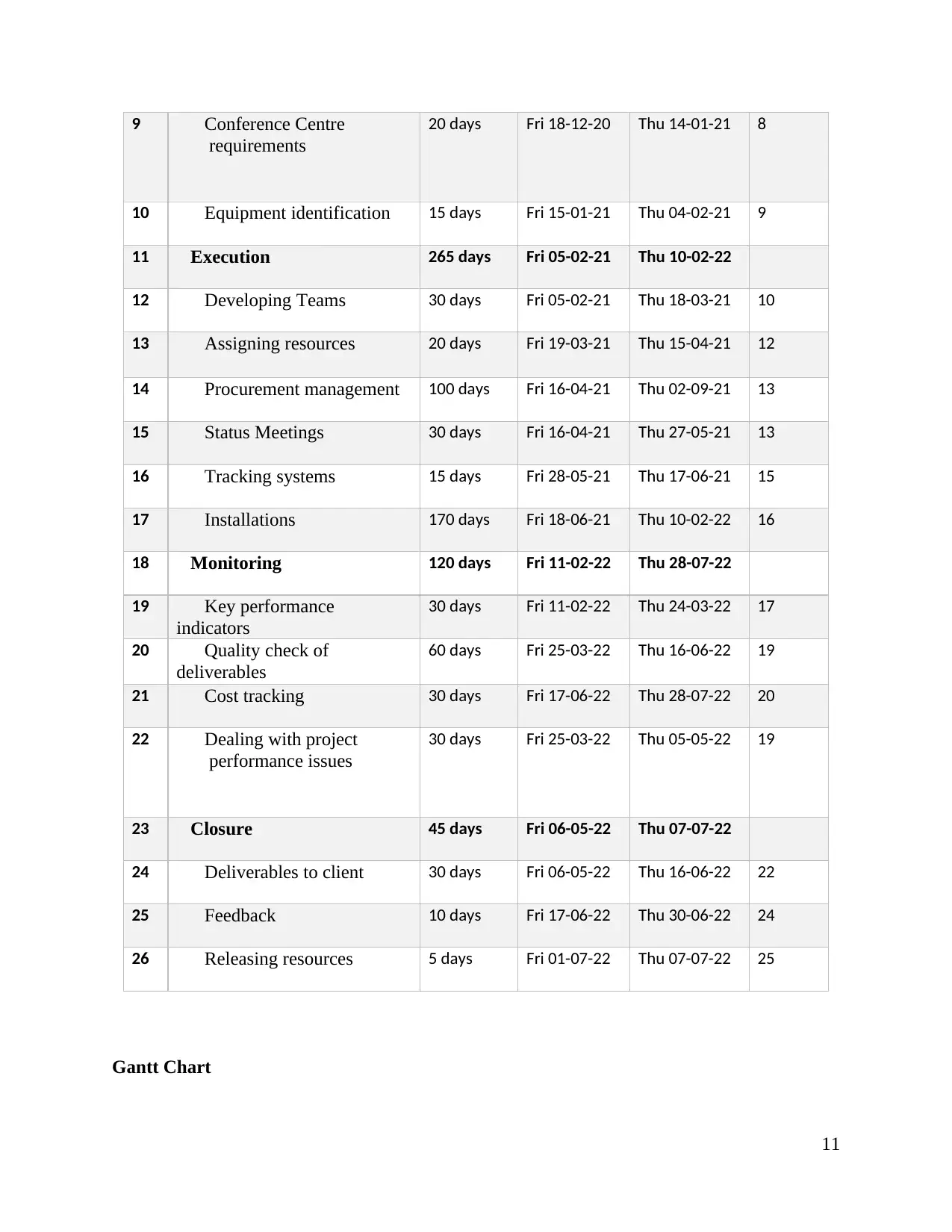
9 Conference Centre
requirements
20 days Fri 18-12-20 Thu 14-01-21 8
10 Equipment identification 15 days Fri 15-01-21 Thu 04-02-21 9
11 Execution 265 days Fri 05-02-21 Thu 10-02-22
12 Developing Teams 30 days Fri 05-02-21 Thu 18-03-21 10
13 Assigning resources 20 days Fri 19-03-21 Thu 15-04-21 12
14 Procurement management 100 days Fri 16-04-21 Thu 02-09-21 13
15 Status Meetings 30 days Fri 16-04-21 Thu 27-05-21 13
16 Tracking systems 15 days Fri 28-05-21 Thu 17-06-21 15
17 Installations 170 days Fri 18-06-21 Thu 10-02-22 16
18 Monitoring 120 days Fri 11-02-22 Thu 28-07-22
19 Key performance
indicators
30 days Fri 11-02-22 Thu 24-03-22 17
20 Quality check of
deliverables
60 days Fri 25-03-22 Thu 16-06-22 19
21 Cost tracking 30 days Fri 17-06-22 Thu 28-07-22 20
22 Dealing with project
performance issues
30 days Fri 25-03-22 Thu 05-05-22 19
23 Closure 45 days Fri 06-05-22 Thu 07-07-22
24 Deliverables to client 30 days Fri 06-05-22 Thu 16-06-22 22
25 Feedback 10 days Fri 17-06-22 Thu 30-06-22 24
26 Releasing resources 5 days Fri 01-07-22 Thu 07-07-22 25
Gantt Chart
11
requirements
20 days Fri 18-12-20 Thu 14-01-21 8
10 Equipment identification 15 days Fri 15-01-21 Thu 04-02-21 9
11 Execution 265 days Fri 05-02-21 Thu 10-02-22
12 Developing Teams 30 days Fri 05-02-21 Thu 18-03-21 10
13 Assigning resources 20 days Fri 19-03-21 Thu 15-04-21 12
14 Procurement management 100 days Fri 16-04-21 Thu 02-09-21 13
15 Status Meetings 30 days Fri 16-04-21 Thu 27-05-21 13
16 Tracking systems 15 days Fri 28-05-21 Thu 17-06-21 15
17 Installations 170 days Fri 18-06-21 Thu 10-02-22 16
18 Monitoring 120 days Fri 11-02-22 Thu 28-07-22
19 Key performance
indicators
30 days Fri 11-02-22 Thu 24-03-22 17
20 Quality check of
deliverables
60 days Fri 25-03-22 Thu 16-06-22 19
21 Cost tracking 30 days Fri 17-06-22 Thu 28-07-22 20
22 Dealing with project
performance issues
30 days Fri 25-03-22 Thu 05-05-22 19
23 Closure 45 days Fri 06-05-22 Thu 07-07-22
24 Deliverables to client 30 days Fri 06-05-22 Thu 16-06-22 22
25 Feedback 10 days Fri 17-06-22 Thu 30-06-22 24
26 Releasing resources 5 days Fri 01-07-22 Thu 07-07-22 25
Gantt Chart
11
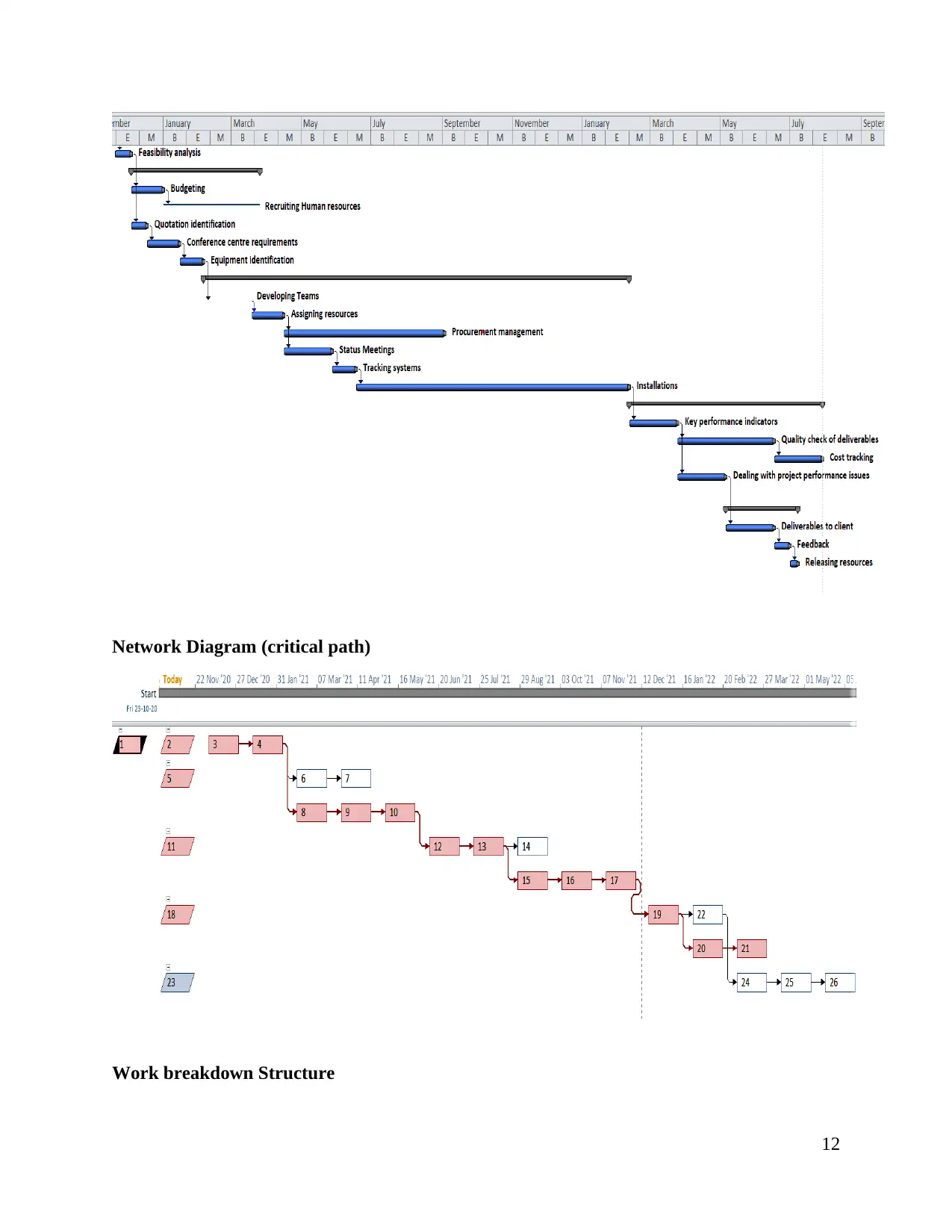
Network Diagram (critical path)
Work breakdown Structure
12
Work breakdown Structure
12
⊘ This is a preview!⊘
Do you want full access?
Subscribe today to unlock all pages.

Trusted by 1+ million students worldwide
1 out of 18
Related Documents
Your All-in-One AI-Powered Toolkit for Academic Success.
+13062052269
info@desklib.com
Available 24*7 on WhatsApp / Email
![[object Object]](/_next/static/media/star-bottom.7253800d.svg)
Unlock your academic potential
Copyright © 2020–2025 A2Z Services. All Rights Reserved. Developed and managed by ZUCOL.




